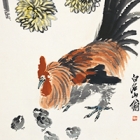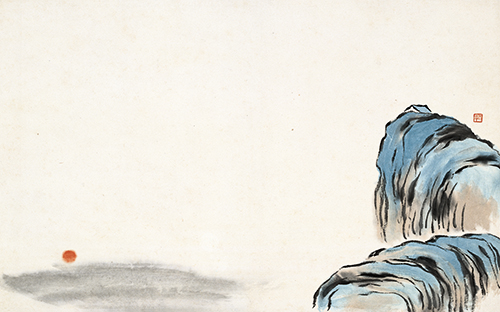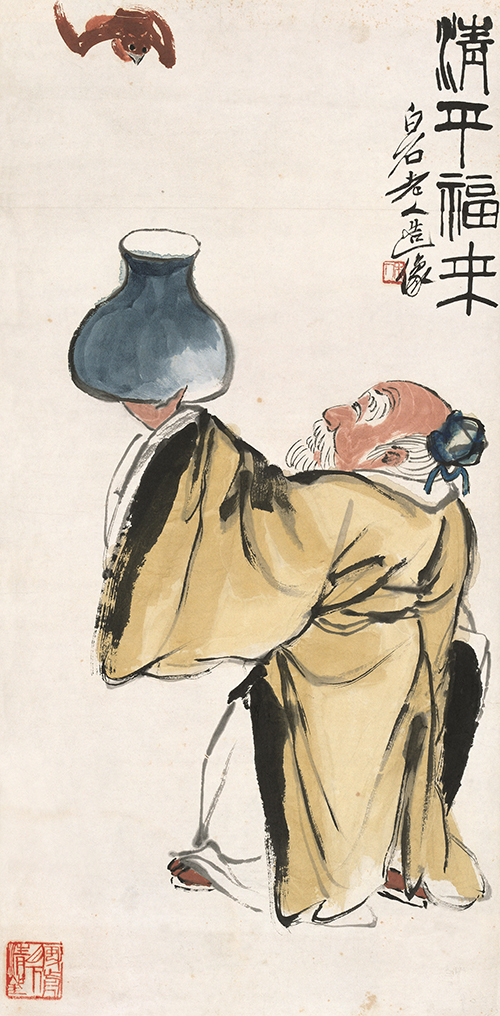Highlights of the Exhibition
Flowers and Trees: Qi Baishi’s Grand Beginnings
While working as a craftsman, Qi Baishi delighted his patrons by coming up with new patterns for traditional motifs like plum blossoms, orchids, bamboo, and chrysanthemums. Later, he continued to hone his technique through tireless efforts such as studying painting manuals, copying paintings from bygone eras, and sketching from nature. As a result, his flowers and trees became even more stunning with bright colors, vibrant splashes of ink, and fluid brushwork.
Liquor for Longevity
By Qi Baishi
20th century
Lent by Beijing Fine Art Academy
[On exhibit November 27–December 25, 2018]
Birds and Animals: Captivating Gazes
After boldly filling in flowers and trees, Qi Baishi would add life to his scenes with birds such as ducks, chickens, and hawks. A particularly striking aspect of these birds is their expressive eyes. Baishi learned the importance of depicting birds with a sense of dynamism from his mentor, Hu Qinyuan. This teaching is reflected in his birds’ human-like gazes.
Chickens and Chrysanthemum
By Qi Baishi
20th century
Lent by Beijing Fine Art Academy
[On exhibit November 27–December 25, 2018]
Insects: Precise Depictions with Matchless Technique
Qi Baishi is said to have enjoyed closely observing insects and capturing their forms. Although he tends to be thought of as an artist who favored simpler representations in his works, Baishi’s intricate depictions of insects astonish with their precise grasp of fine details such as antennas and the patterns of legs and wings. His use of empty space in placing tiny insects on the page also showcases his artistic sensibilities.
Album of Insects in Gongbi style (Painting 1: Flowers and Swallowtail Moths)
By Qi Baishi
dated 1949
Lent by Beijing Fine Art Academy
[On exhibit October 30–November 25, 2018]
Fish and Shrimp: Mastery of a Familiar Subject
Qi Baishi used subtle ink washes to produce many paintings depicting schools of fish, shrimp, crabs, and other aquatic life. Born in a farming village, Baishi is said to have familiarized himself with the ceaseless underwater gatherings and scatterings of these creatures as a young boy. His works expertly convey the continual movement and vitality of aquatic life.
Shrimps
By Qi Baishi
20th century
Lent by Beijing Fine Art Academy
[On exhibit October 30–November 25, 2018]
Landscapes: Figurative Art Born from Travels Far and Wide
After the age of forty, Qi Baishi had more opportunities to tour the country. While comparing the traditional representations of landscapes that he had learned from manuals and old paintings with real-life scenery, he grew to establish his own original style. Baishi’s landscape paintings are notable for their distinctive compositions, simple and vigorous brushstrokes, and vibrant, gorgeous colors.
Landscapes (No. 3)
By Qi Baishi
dated 1910
Lent by Beijing Fine Art Academy
[On exhibit October 30–November 25, 2018]
Gods and Human Figures: The Culmination of Qi Baishi’s Originality
Although Qi Baishi also produced realistic portraits and detailed paintings of beautiful women earlier in his career, he later grew to favor simpler forms based on robust lines. Baishi’s human depictions delight the eye with the exaggerated, almost comical figures born from his deft brushstrokes.
Good Fortune Comes in Peace
By Qi Baishi
20th century
Lent by Beijing Fine Art Academy
[On exhibit November 27–December 25, 2018]
Calligraphy and Seals: Rich Aesthetics and Sensitivity
Qi Baishi developed an interest in seal carving at a young age, and also loved the calligraphy upon which it was based. After studying the carvings of the Zhe School (Xiling School) and Zhao Zhiqian, he later explored the seal scripts of the Qin dynasty to the Three Kingdoms period, establishing his own unique styles and chiseling techniques. Baishi’s seal carving is characterized by rigid, well-modulated thick and thin lines, simple shapes, and a seal composition that emphasizes the contrast between the red of the ink and the white of the paper. His bold, dynamic chiseling style also reflects his experience as a carpenter and joiner.
Couplet in Four-character Phrases in Seal Script
By Qi Baishi
dated 19451
Lent by Beijing Fine Art Academy
[On exhibit November 27–December 25, 2018]
Couplet in Four-character Phrases in Seal Script
By Qi Baishi
dated 19451
Lent by Beijing Fine Art Academy
[On exhibit October 30–November 25, 2018]
Study: Origins of Creation
In Qi Baishi’s younger and poorer days, he is said to have borrowed picture books from acquaintances, and copied them by laying thin sheets of paper over each page and tracing the pictures with fine outlines. Later, he continued to accumulate sketches by carefully copying old paintings and drawing real-life scenery on his travels. These sketches could be considered the origins of Baishi’s creative work.
Although Baishi was with a non-academic family background, he began learning how to compose poems to serve as inscriptions on his paintings. Poetry eventually became one of his great pleasures. His artistry lives and breathes in the manuscripts of his poem anthologies and the journal in which he recorded his daily inspirations.
Page Top
![]() PDF (
PDF (![]() 749KB)
749KB)










